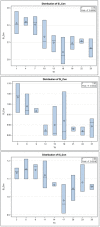Higher Fertilizer Inputs Increase Fitness Traits of Brown Planthopper in Rice
- PMID: 28680158
- PMCID: PMC5498570
- DOI: 10.1038/s41598-017-05023-7
Higher Fertilizer Inputs Increase Fitness Traits of Brown Planthopper in Rice
Abstract
Rice (Oryza sativa L.) is the primary staple food source for more than half of the world's population. In many developing countries, increased use of fertilizers is a response to increase demand for rice. In this study, we investigated the effects of three principal fertilizer components (nitrogen, phosphorus and potassium) on the development of potted rice plants and their effects on fitness traits of the brown planthopper (BPH) [Nilaparvata lugens (Stål) (Homoptera: Delphacidae)], which is a major pest of rice in Bangladesh and elsewhere. Compared to low fertilizer inputs, high fertilizer treatments induced plant growth but also favored BPH development. The BPH had higher survival, developed faster, and the intrinsic rate of natural increase (r m ) was higher on well-fertilized than under-fertilized plants. Among the fertilizer inputs, nitrogen had the strongest effect on the fitness traits of BPH. Furthermore, both the "Plant vigor hypothesis" and the "Plant stress hypothesis" were supported by the results, the former hypothesis more so than the latter. These hypotheses suggest that the most suitable/attractive hosts for insect herbivores are the most vigorous plants. Our findings emphasized that an exclusive focus on yield increases through only enhanced crop fertilization may have unforeseen, indirect, effects on crop susceptibility to pests, such as BPH.
Conflict of interest statement
The authors declare that they have no competing interests.
Figures









References
-
- FAO. Rice is life. http://www/fao.org/newsroom/en/focus/200436887/indea Accessed 08 December (2004).
-
- Chelliah, S. & Gunathilagaraj, K. Pest Management in Rice-Current Status and Future Prospects. http://www.rkmp.co.in. Accessed 30 September (2012).
-
- British Council. Necesitamos arroz para “alimentar al mundo, https://learnenglish.britishcouncil.org/es/magazine-articles/necesitamos... Accessed 04 June 2016.
-
- Heong, K. L. Pest management in tropical rice ecosystems: new paradigms for research. Proceedings of International Workshop on Pest Management Strategies in Asian Monsoon Agroecosystem, 15–18 November 1995. National Agricultural Experimental. Station. Ministry of Agriculture Forestry and Fisheries, Kumamoto, Japan (1996).
-
- Sogawa, K. Planthopper Outbreaks in Different Paddy Ecosystems in Asia: Man-Made Hopper Plagues that Threatened the Green Revolution in Rice. In: Heong, K. L. et al. editors, Rice Planthoppers: Zhejiang University Press; 2015. Hangzhou and Springer Science + Business Media Dordrecht 2015, doi:10.1007/978-94-017-9535-7_2 (2015).
Publication types
MeSH terms
Substances
LinkOut - more resources
Full Text Sources
Other Literature Sources

